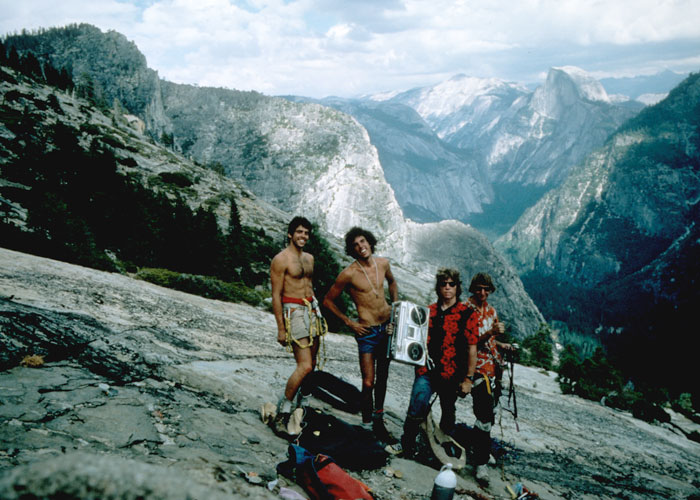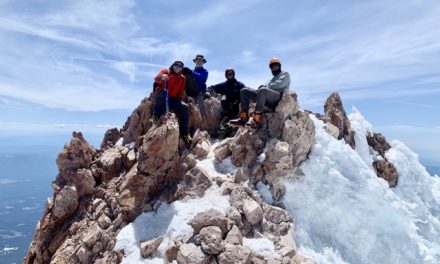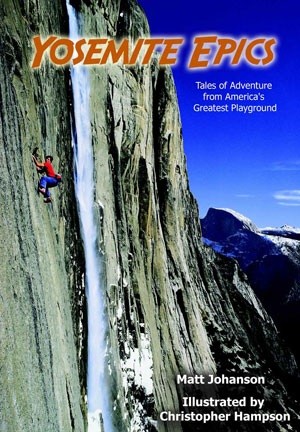- Yosemite E-Biking - 01/12/2023
- The Yosemite Climbing Association - 09/01/2022
- Ryan Sheridan & Priscilla Mewborne - 05/17/2022
It was a time of establishing routes with strict ethics, mastery and boldness – but that was about to change
By Chris Van Leuven
July 1988: Scott Cosgrove and Dave Schultz are free climbing a 1,500-foot face of golden stone up the remote South Face of Half Dome, tenuously gripping feldspar knobs and credit card edges, on the most difficult route of their lives. Not only is the grade high, 5.12d, the route is so dangerous that a fall in many places will result in a trip to the hospital. Think shattered legs, open skull fractures. Falls so long you scream twice before stopping.
To avoid low-friction conditions found in the heat of the day – which makes the rubber on their boots slip and their fingers sweat — they wake at 5am, toil their way up the route, Southern Belle, and push themselves over the edge mentally and physically to see what they’re capable of.
“The runouts are epic,” Alex Honnold told Alpinist Magazine in 2016 soon after Cosgrove’s death. “Some of the pitches have a single piece of protection. It’s a definite testpiece that has lived on.”
Cosgrove wrote in Alpinist, “We pulled it off by a whisper.”
The first ascent of Southern Belle was thirty years ago, a time before social media, Internet forums and video news, so only the in-person friends of Cosgrove and Schultz knew or cared about what they did. Big wall pioneer and longtime Yosemite Search and Rescue member John “Deucey” Middendorf says that was part of the motivation – the isolation was a motivator.
“The goal was to get as close to the edge, where all the chaos happens, and come back,” Middendorf told Adventure Sports Journal outside a Megaplex Theater in Salt Lake City, UT. The edge, he explained, was fascinating. To Middendorf, this meant free soloing near his limit (5.11) and nailing pitons into fragile, expanding flakes (A5) on El Cap, where death or serious injury would occur if he fell.
But there was reason to this madness. Carlos Castaneda’s book A Separate Reality (1971) was still in vogue, just as it was during the 1970s with the Southern California Stonemasters, who stood on the shoulders of the generation of climbers before them, those from the Yosemite Golden Age. The Golden Age, late ‘50s throughout the ‘60s, was the period where the big walls were just starting to get climbed with regularity. The ‘70s brought harder big wall first ascents and also an emphasis on free climbing. The ‘80s blended the two together.
All three of these generations had their eyes on climbing El Cap and Half Dome and to do it better than those before them. Some took drugs for mind expansion, to open doors. Some were spurred on from the ethos of their group.
During the ‘80s, these ripped athletes, dressed in muscle shirts and painter’s pants, set out on Yosemite’s grand, glacier-polished walls to test their mettle.
Things like money and time didn’t exist to this tribe. Only climbing hard mattered. To sustain themselves, they lifted abandoned food off nearby cafeteria tables and some collected the occasional Search and Rescue check. Others lived off saved construction wages. It was Peter Pan Land. “Once you left you could never come back,” longtime Valley local Dean “Bullwinkle” Fidelman said over the phone from his car in Ventura. “To [live in Yosemite] you’d have to give up so much.”
To keep from losing their piece of paradise, tribes spent upwards of 10 years in the Valley, living in tents, caves or their vans so they could be in climbing’s center of the universe and etch their names into the history books.
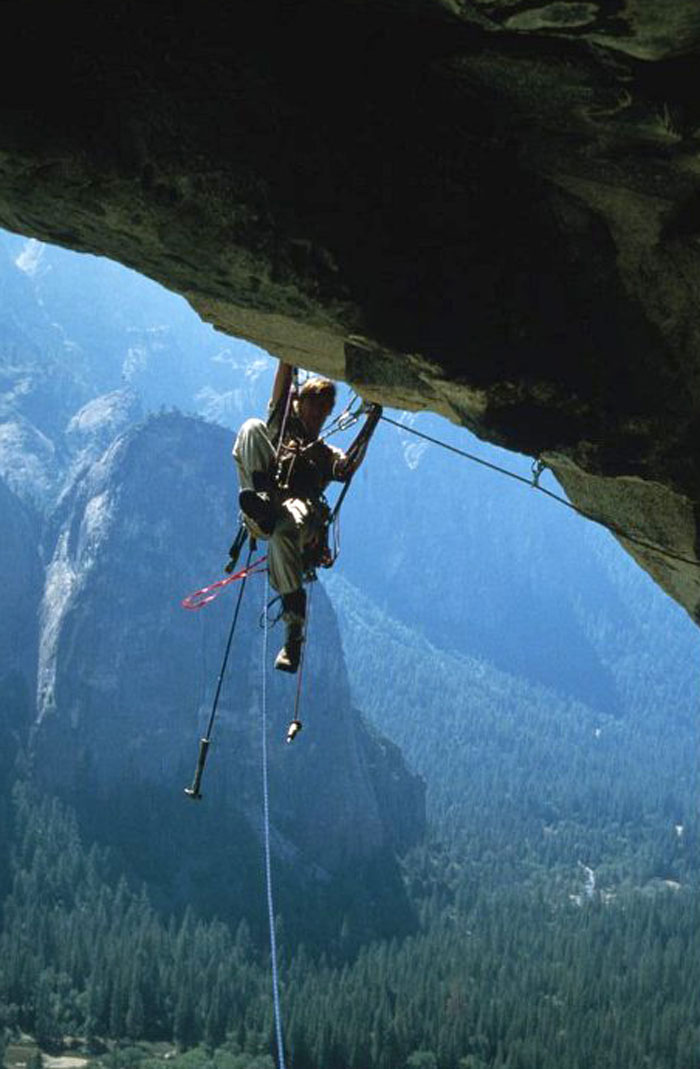
Ethics Were Everything
“What had happened in the ‘80s was that traditional free climbing hit a wall,” Bullwinkle, says. “The only obvious thing to do was free climbing on El Cap. But no one was changing the way [they] free climbed.”
The style in which Shultz and Cosgrove were climbing was how it had always been done in Yosemite both for practical reasons (the walls were so tall), and also because it was the ethic: ground up, no falls and sticking your neck out.
And there were ethics police, like the late free soloist John Bachar who would cry foul if anyone deviated from the norm, like hanging on the rope (hangdogging) while rehearsing a move. Bachar was leading the charge of sustaining traditional climbing. Fights broke out over ethics. Cars were vandalized.
Free climbing El Cap required deviating from the norm – it was just too massive to free it any other way.

Don Reid on the Salathé Wall, 1986 (Ken Yager).
Changing Styles and the First Competitions
Though Ray Jardine had been hangdogging with regularity in the Valley since the ‘70s (much to the dismay of some climbers), he also experimented with chiseling on El Cap in order to free climb blank sections, which further ostracized him from his peers. [Though hangdogging has since become accepted, chipping is still a no-no – Ed.]
Although by the mid-‘80s hangdogging was still new and practiced by the best climbers in the US outside of the Valley, including by Bobbi Bensman, Lynn Hill, Alan Watts and the late Todd Skinner, it was not yet accepted within Yosemite’s gates. Australian climber Kim Carrigan pushed hangdogging hard in Yosemite but he was met with resistance. This practice opened the door to harder climbing, which could equate to a spot on the podium of the World Cup events being held in Europe. If the Europeans weren’t afraid to hang on the rope to work out a move, why should the Americans?
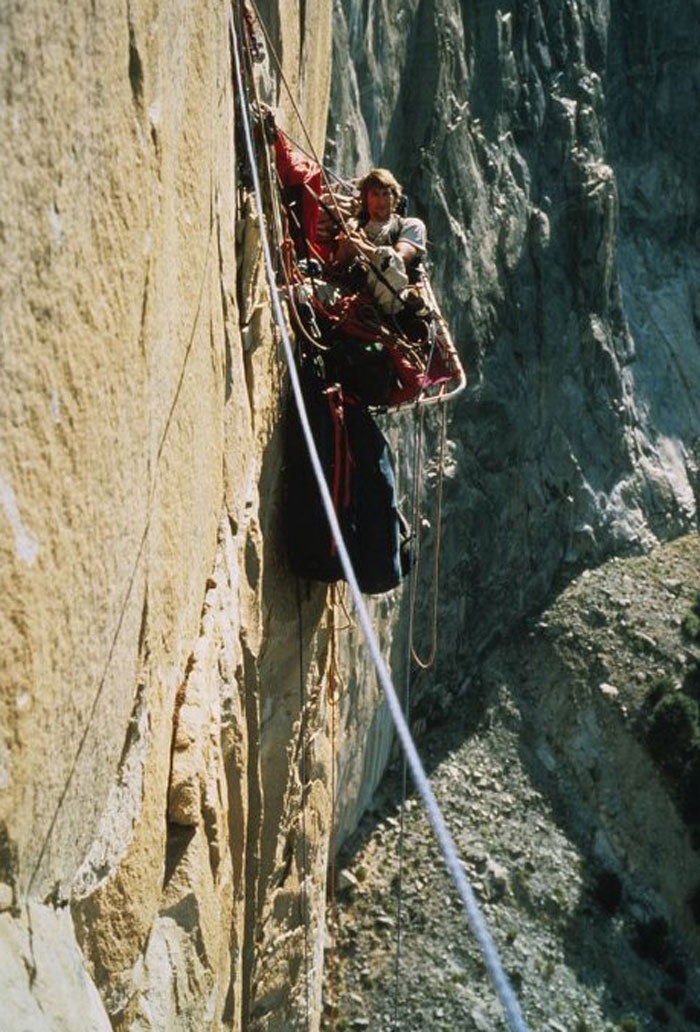
Middendorf after leading an A5 pitch on the Atlantic Ocean Wall (AO), 1985 (John Barbella).
Cowboys, the Captain & a Loose Block
The same summer that Cosgrove and Schultz were risking life and limb up on Half Dome’s smooth South Face, so, too, were Midwest climbers Todd Skinner and Paul Piana. For 30 days they climbed ground-up on El Cap’s Salathé Wall (put up in 1961), hangdogging when necessary, intent on making the route’s first free ascent. If successful, they would be the first to free the formation one thousand feet taller than Half Dome.
However, just as the duo was completing their feat, rated 5.13, they anchored their rope to a few pitons next to a giant loose block and mistakenly hauled their gear from the mass, which ripped from the wall.
“Todd remembers me putting my hands out at the block and yelling ‘No!’” Piana wrote in the American Alpine Journal. “I recall a loud crack like a rifle shot, and then more pummeling, and suddenly everything stopped spinning and I could just peek back up over the edge. Everything was in tatters, ropes pinched off and fused – it appeared that they had all been cut.” The clipped pitons to the side of the block kept them from falling to their deaths.
Though injured and badly shaken, Piana and Skinner slowly made their way down to the Valley floor.
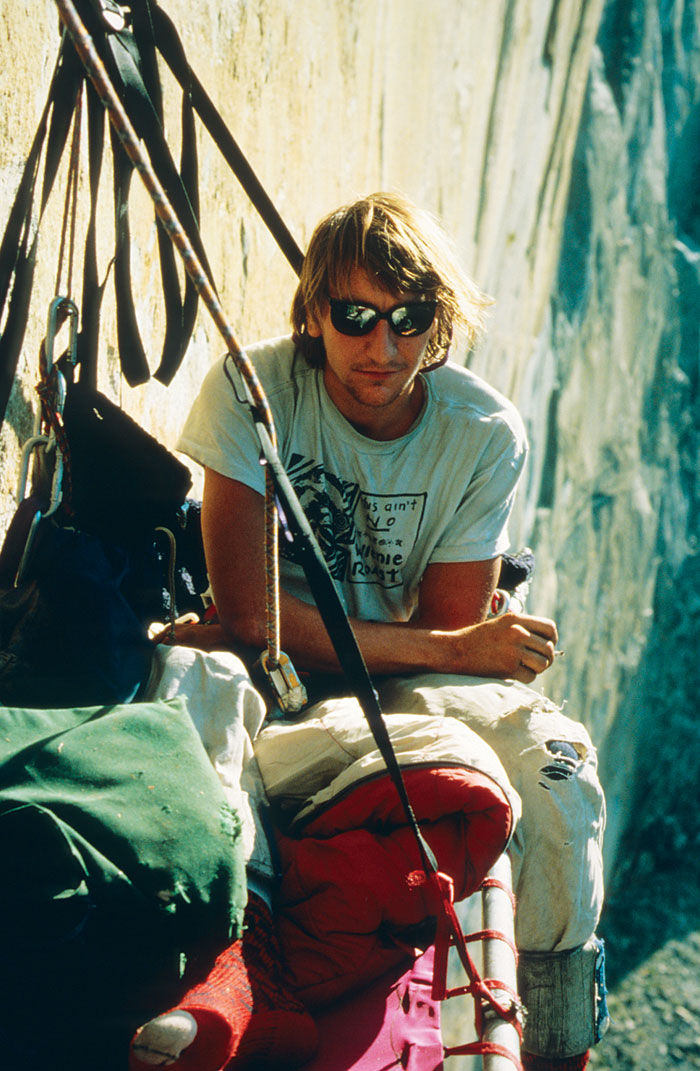
Middendorf belaying on the AO Wall (John Barbella).
Climbing Big Walls Free
Five years after Skinner and Piana’s success on El Cap, Lynn Hill (closely associated with the Stonemasters) freed El Cap’s Nose route, which went at 5.14a, coining the phrase “it goes boys.” Two years later she upped the ante again and freed the route in a day.
Today big wall free climbing is definitely in vogue in Yosemite, and standards continue to advance. In 2015, the world watched in awe as Tommy Caldwell and Kevin Jorgeson freed the hardest route in the world, El Cap’s Dawn Wall. In addition to physically hard moves, their route has big runouts on marginal gear placements. It’s a fusion of opposite styles that were in conflict during the ‘80s and ‘90s.
The world watched again, on June 3, 2017, when Alex Honnold climbed Freerider, a variation to the Salathé Wall, free solo (as in without a rope) in fewer than four hours.
To prepare for his historic ascent, Honnold spent years preparing, including rappelling into key sections to inspect the moves and climbing the route bottom to top 12 times. By the time he reached the spot where Skinner and Piana nearly died when their ropes were severed by a falling rock, Honnold was already running to the summit out of joy and excitement.
What’s next in Yosemite? Will there be a ground-up bolting resurgence? Will new routes be established after weeks of pre-inspection? Will El Cap get free soloed again? Time will tell. But one thing is for sure; climbers will continue to push the standards, whether purely for themselves or also to publish their feats on social media.
As the Yosemite ethics question goes: “If you free soloed a route and told someone about it, was it really a free solo?”

